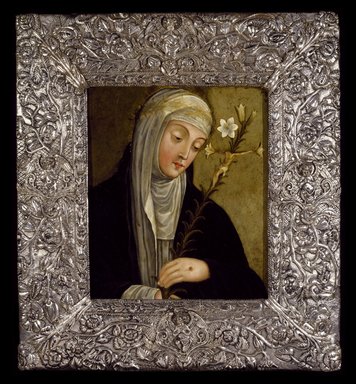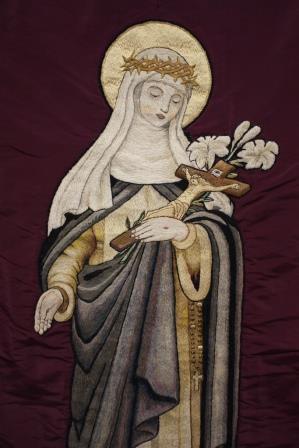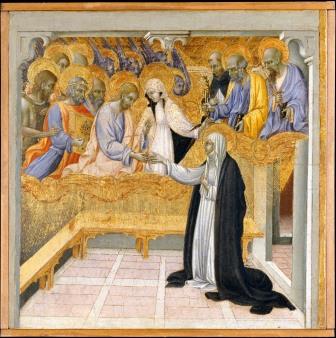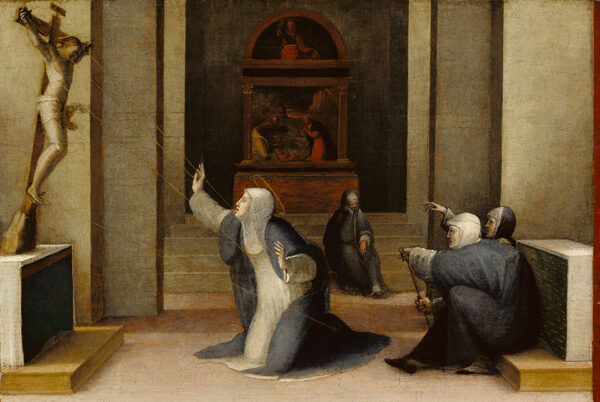
Last updated: April 29, 2024
Catherine of Siena (1347-1380) was born Caterina di Giacomo di Benincasa to a family of dye merchants in Siena, Italy. She began having mystical experiences in her childhood and decided at age 7 to dedicate her life to God. She did not go to school as a child, but she listened carefully at Mass and she learned about the lives of saints from her orphaned cousin Tommaso della Fonte, who was living with her family while he was studying to be a priest.

Encouraged by Tommaso, as an adolescent, she defied her parents by cutting her hair and refusing to marry, expressing her desire to become a nun. Legend says that her father reacted severely, giving her all of the manual household chores, such as cooking, scrubbing, and laundry for the very large family. However, Catherine found a way to be present to God, even while laboring in the kitchen. Then, one day her father saw a white dove appear above Catherine’s head as she paused in her work to pray. He decided to help her devote herself to God, so he hired a servant and allowed Catherine to stay enclosed in her room, in order to meditate in private.
When she was 18, Catherine became a tertiary (lay associate) of the Dominican order and received her habit. She focused on a life of prayer, penance, fasting, and solitude. As much as she treasured the solitary life, Catherine was frustrated as she struggled to teach herself to read and she prayed to God for help. Shortly thereafter, her prayer was answered and she started to read fluently, allowing her to begin following the Divine Office. In 1367, she experienced a mystical espousal to Christ, as-depicted in the fifteenth century painting by Giovanni di Paolo, shown below and to the left. As a result, she felt she was being called to leave her solitary room in order to serve the sick and poor in the community. Just one year later, Catherine’s father died and there was substantial political turmoil in Siena. It was during this time that she began ministering to those who were imprisoned and facing execution.

Catherine’s world and interests expanded, and she became drawn into church politics, beginning around 1374. She was summoned to Florence by her order, to answer to numerous accusations. However, instead of censure, she was sent back to Siena, entrusted to the care of the well regarded Dominican scholar, Raymond of Capua. He served as her confessor and spiritual director, introducing her to wider church circles and improving her credibility. She began traveling around Italy with Raymond, preaching repentance and building up a reputation and many followers. According to her biographers, during one of her trips to Pisa, as she was praying before a crucifix, she received the stigmata wounds of Christ on her hands and feet. This experience is depicted in the Mannerist painting by Dominico di Pace Beccafumi (1486-1551), shown below and to the right.
In 1376, she traveled to Avignon as Ambassador from the Republic of Florence to try to convince Pope Gregory XI to return the papacy to Rome. Scholars are still debating how influential she was in the eventual return, but it is clear that she did have contact with many church leaders and that she met with the pope to promote the idea. Catherine was a strong advocate for reform of the clergy and maintained an extensive correspondence with church leaders. In addition, she founded a monastery for women at the fortress of Belcaro, just outside of Siena in 1377, and this allowed her to collaborate with other religious women to continue her work caring for the ill and poor of her community.

Catherine was also a theologian who wrote a major treatise, The Dialogue of Divine Providence, in response to an ecstatic vision she received. In 1380, she died at the age of 33 in Rome from health issues that were caused by her extreme asceticism. Catherine was canonized by Pope Pius II in 1461 and her feast day is April 29.
In 1970, Catherine of Siena was declared a Doctor of the Church by Pope Paul VI, one of the first two women to be granted this status. The title of Doctor of the Church is reserved for people who greatly influenced the development and theology of the church. The other three female Doctors of the Church are Hildegard of Bingen (2012), Thérèse of Lisieux (1997), and Teresa of Avila (1970).
Here is the quote I have selected for my book and the acrylic monoprint I made to go with it. I had really wanted to find the source of Catherine’s quotation “Nothing great is ever achieved without much enduring.” I love this quote and it really resonates with me as being so true! When I reflect on my life, I see that persistence has definitely been a very important component that has helped me through the more difficult times. So I still don’t know exactly where that quote came from, but I gave up looking for it. Maybe you would see that as an ironic lack of persistence on my part 🙂 but I read both The Dialogue and a book of her prayers and even I have my limits. Fortunately, instead I ended up with this longer and excellent quote from The Dialogue that also talks about the importance of perseverance.

The soul, once on her way, must cross over by way of the teaching of Christ crucified, truly loving virtue and hating vice. If she perseveres to the end, she will come to the house of self-knowledge, where she shuts herself up in watching and continuous prayer, completely cut off from worldly company. Why does she shut herself up? Through fear, because she knows how imperfect she is. And through her longing to attain a genuine and free love. She sees well that there is no other way to attain it and so she waits with a lively faith for My coming so that she may grow in grace. How does one come to know lively faith? By persevering in virtue. You must never turn back for anything at all.
Catherine of Siena (1347-1380)
I especially like the idea that perseverance leads us to “the house of self-knowledge” because I think that learning about ourselves is crucially important to our development as human beings. And I believe that when each of us first turns inward to explore the landscape of our inner life, this can become the beginning point of an honest and lovely spiritual life.
UPDATES: This blog post was updated on August 10, 2023 to include another image of Catherine of Siena, to check hyperlinks, and to make minor editorial changes. It was updated again on April 29, 2024 to add another image, a reference to the other three female Doctors of the Church, and minor editorial changes.
Reference 1: Catherine of Siena (Noffke, Suzanne ed. and trans.) “The Dialogue,” Paulist Press, New York, NY, 1980.
Reference 2: Catherine of Siena (Noffke, Suzanne ed. and trans.) “The Prayers of Catherine of Siena,” Second Edition, Authors Choice Press, New York, NY, 2001.
Reference 3: Vinje, Patricia Mary, “Praying With Catherine of Siena,” Saint Mary’s Press, Winona, MN, 1990.
Reference 4: Krier, Rebecca, Christianity and St. Catherine of Siena: It’s Complicated, Women in Theology website, May 16, 2016.
Image 1: Saint Catherine of Siena, unknown 17th century Italian or Peruvian painter, Brooklyn Museum, Brooklyn, NY, accession number 48.206.84.
Image 2: Detail of St. Catherine from embroidered banner at the Dominican convent in Stone, Staffordshire. Photo credit – Fr. Lawrence Lew, CC BY-NC-ND 2.0, flickr.com, September 29, 2008.
Image 3: The Mystical Marriage of Saint Catherine of Siena, Painting by Giovanni di Paolo, circa 1460 or earlier, Metropolitan Museum of Art, New York, NY, accession number 1997.117.2.
Image 4: Saint Catherine of Siena Receiving the Stigmata, Painting by Getty Museum, Los Angeles, CA, public domain.
Image 5 “Catherine Crosses Over,” acrylic monoprint by Julie Henkener, 2017.















Leave a Reply
Join the conversation by submitting a comment to this blog post below.